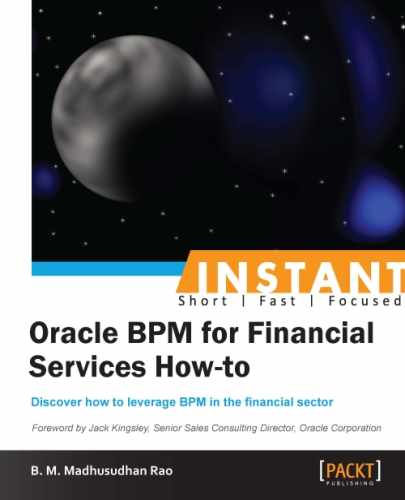Enterprise Organizations are increasingly adopting Oracle Business Process Management (BPM) to increase their organizational efficiency and excellence. As per industry analyst reports, such as those from Gartner and Forrester, BPM has been at the top of the senior management focus list for the last four to five years, and BPM spending has been at a multi-billion dollar level. BPM's ability to streamline the business process and integrate with business partners has been a key focus area both from an IT and business point of view. BPM's out-of-the-box capabilities with respect to human workflow, notifications, simulations, integration with various applications through adapters and document management systems had been a key factor both from a Solution Architecture and Development view of a Business process.
BPM is built on Oracle's SOA (Service Oriented Architecture) Suite infrastructure. BPM Suite 11g provides enhanced support for application integration services, business events, Web 2.0, E2.0, and high scalability. BPM has sufficient easy-to-use features to make it also suitable for small to complex enterprise projects.
This book covers various aspects of BPM from a financial services point of view, and looks at how BPM can help in various organizational roles such as Process Administrator, Process Analyst, Process Owner, and Process Participants. Each of the recipes cover a how-to-do activity. We start with setting up the development environment to integrate with a business partner and end at a complete enterprise portal, which helps in achieving an organization's goals and customer satisfaction.
Setting up the development environment (Simple), discusses some of the key challenges faced in the financial services industry such as banks, mortgage firms, insurance companies, stock brokerage firms, and so on. We will also be setting hands on a development environment and configuring Oracle BPM, Webcenter Portal, and Webcenter Content to work together.
Modeling a home loan business process (Intermediate), is seen more from a process analyst's perspective that comprises of modeling the business process, setting up business rules to determine Platinum/Gold or non-eligible customers for a home loan. These business rules are editable by the process analyst at a later point in time as and when business requirements change.
Implementing a home loan business process (Advanced), shows how a process developer would implement some of the core logic to calculate the EMI amount for the requested loan amount for a given period of time at a rate of interest decided by the business analyst. There are different EMI options—fixed and variable EMI—that customers can choose from. The auto-generated IDs can be used across the loan application process up to loan fulfillment.
Deploying and testing a process workflow (Advanced), takes a closer look at the home loan process. It covers workflow approvals from one stage to another based on the organization's hierarchy. We will also discuss some of the core BPMN modeling techniques and service re-usability across the process, some of the best practices, deployment and process testing.
Administering processes (Advanced), discusses process escalation, setting process deadlines, document management capabilities, process simulation, and cost and time analysis that helps the process owner take some of the key business decisions in an overall business process.
Changing a business process by the process analyst (Advanced), covers process change management, and the process audit trail in detail, it also demonstrates using the process composer to edit and change the business rules and the process flow as per the changes in the business requirement.
Creating business reports for process owners (Intermediate), covers some of the key real-time reporting requirements of the business process owners. This recipe covers the business activity monitoring application to track the real-time process data in BAM dashboard and helps the process owner in making some of the key decisions with respect to the business.
Participating in a business process (Intermediate), discusses re-usable services and sub processes. It also covers how the processes can get back to the customer, asking for more information related to regulatory requirements, which then gets verified before the process moves to the next level in the approval chain.
Integrating with business partners (Advanced), following on from the concepts covered in the previous recipe, in this recipe we will be taking a closer look at Oracle Service Bus integration with BPM and access partner services.
Collaborating with customers and end users (Simple), shows how customers and process participants collaborate in a portal environment on web and mobile devices. It covers the bigger picture of enterprise, which comprises not only of business process but also various decision-making reports and context-based documents related to the business.
